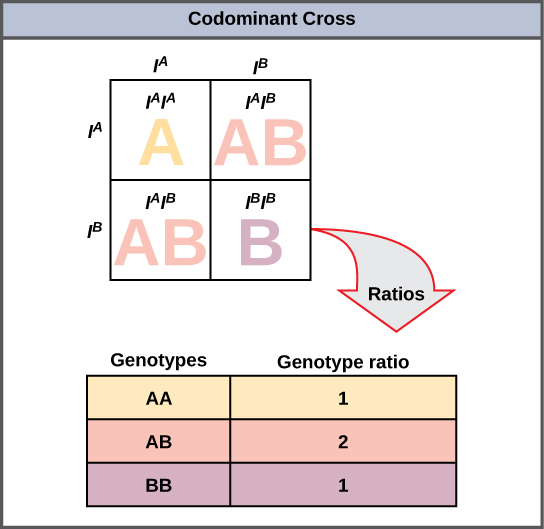Exceptions to Mendel’s Laws
Introduction
Aside from Mendel’s work, researchers have been able to examine other model organisms to identify additional patterns of inheritance. One such model which demonstrates the concept of Incomplete Dominance is the snapdragon plant. Let’s see how flower color is inherited in the snapdragon…
Learning
Incomplete Dominance
In incomplete dominance, the phenotype of heterozygotes is intermediate between the phenotypes of the two homozygotes. A great example of this is the flower color characteristic of some plants where true-breeding varieties produce either red or white flowers.
In this instance the allele for red flower color is designated as R. In contrast the allele for white flower color is designated r. When these two true-breeding strains are crossed to produce an F1 generation, the following results are seen:

In this case, neither the red nor the white alleles are dominant or recessive to one another. Rather, it appears as though the two traits are expressed simultaneously producing an intermediate phenotype – pink flowers with Rr genotype (think of what happens when you mix red and white paint together). This is known as Incomplete Dominance.
Codominance
A pair of alleles may also exhibit a phenomenon known as “codominance”, in which the phenotype of a heterozygote is determined equally by each allele. A well-known example of codominance is seen in human blood types. For the ABO blood typing system, there are three possible alleles which determine a person’s blood:
- (IA) Type A blood
- (IB)Type B blood
- (iI)Type O blood
People with type A blood have the A glycoprotein on their red blood cells. Represented by triangles in picture.
People with type B blood have the B glycoprotein on their red blood cells. Represented by circles in picture.
People with AB blood type (IAIB) genotype, have both versions of these proteins on their cells.
People with type O blood have NO glycoproteins on their red blood cells.
Since each allele has an equal effect on the phenotype of the IAIB heterozygote, the alleles are considered to be ‘codominant’ to each other.

Therefore the (i) allele is actually recessive to the other two alleles and individuals with genotype (ii) will have no glycoproteins on the surface of their blood cells and will have blood type O.
Polygenic Inheritance
As we have already noted, Mendel studied characteristics that were under simple genetic control: a single gene determined the phenotype for each of the traits he studied. Most traits, however, are actually “polygenic”—that is, they are determined by the interaction of two or more genes.
A great example of a polygenic trait is human skin color. The amount of the pigment melanin produced by an individual determines that person’s skin color. Humans possess multiple genes which influence the production of the melanin. The more melanin present in the skin, the darker the color; the less melanin present, the lighter the skin color.
Using these principles, consider the potential combinations of alleles resulting from two parents who are heterozygous for all three alleles (genotype AaBbCc)

.
We could then chart the number of melanin-producing alleles in this F1 generation to get a distribution curve that looks like this:
Considering how polygenic traits are inherited, it is easy to see how humans share such a wide range of skin colors…
Environmentally Influenced Traits
The phenotype of an individual is not only the result of inheriting a particular set of parental genes. The specific environmental characteristics of the uterus in which a fertilized egg is implanted, the health of the mother, and the living environment of the child can have major impacts on their phenotype. For instance, oxygen deprivation or inappropriate hormone levels can cause lifelong, devastating effects. Likewise, accidents, poor nutrition, and other environmental influences throughout life can alter an individual’s phenotype for many traits.
Let us take a closer look at a common trait which demonstrates sensitivity to temperature. The effects of many alleles depend on internal and external environmental conditions, including body temperature, external temperature, and amount of sunlight exposure. A great example of an environmentally influenced trait is coat color in Siamese cats.

The allele for coat color in Siamese cats is produced at low body temperatures. Because a cat’s extremities tend to be slightly ‘cooler’ than the rest of its body, more melanin is produced in these regions resulting in the characteristic look of the Siamese cat, where the paws, nose, ears, and tail tend to be dark.
Summary
- Incomplete dominance occurs when both traits are expressed equally and neither parental trait is dominant or recessive to one another.
- Codominance occurs when the phenotype of a heterozygote is determined equally be each allele.
- Polygenic traits are determined by the interaction of two or more genes.
- In polygenic inheritance, the range of phenotypes is usually a continuous scale (not distinct groups).
- Environment Conditions (both internal and external) can influence the appearance of many, if not most, traits.
Sources:
“Characteristics and Traits.” By OpenStax Biology 2e. Retrieved from: https://openstax.org/books/biology-2e/pages/12-2-characteristics-and-traits/ Licensed under: CC-BY: Attribution
National Human Genome Research Institute, digital image of flowers, Courtesy: National Human Genome Research Institute. May 21, 2021, Retrieved from: https://www.genome.gov/about-genomics.
“Studying Cell Extensions of the Laws of Inheritances.” By CONCEPTS OF BIOLOGY – 1ST CANADIAN EDITION. Retrieved from https://opentextbc.ca/biology/chapter/8-3-extensions-of-the-laws-of-inheritance/_Licensed under: CC-BY: Attribution
SlideToDoc, Digital image of Polygenetic Inheritance, May 21, 2012, https://slidetodoc.com/search_gs.php?gs=polygenic+inheritance#gsc.tab=1&gsc.q=polygenic%20inheritance
Creative Commons, Digital image of Siamese cat, May 21. 2012, Retrieved from https://search.creativecommons.org/search?q=siamese%20cat/ Licensed under a Creative Commons CC BY 4.0 license